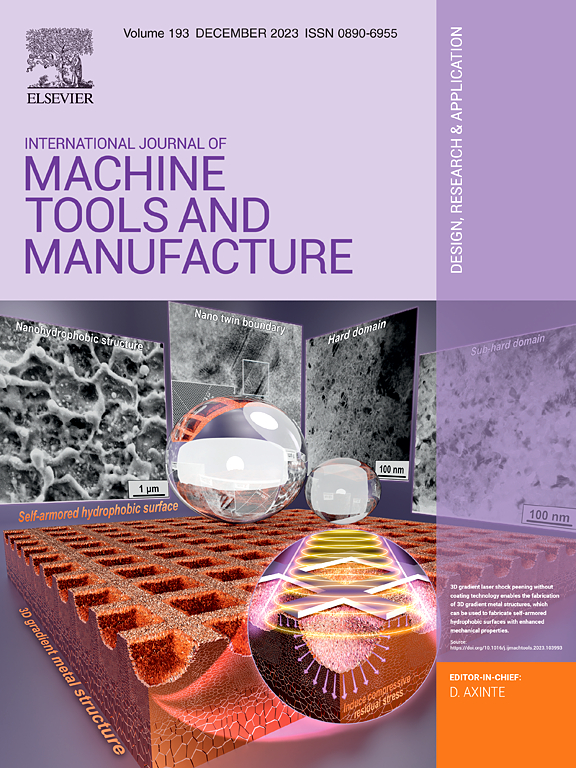Electrical discharge-mechanical hybrid drilling of micro-holes in carbon fibre-reinforced polymers
IF 18.8
1区 工程技术
Q1 ENGINEERING, MANUFACTURING
International Journal of Machine Tools & Manufacture
Pub Date : 2025-02-01
DOI:10.1016/j.ijmachtools.2024.104243
引用次数: 0
Abstract
The machining of deep micro-holes in carbon fibre-reinforced polymers (CFRP) components exhibits a significantly increased demand in the industry. However, it is difficult to machine CFRP deep micro-holes using conventional mechanical drilling and non-conventional processes individually because of the anisotropic and inhomogeneous characteristics of CFRP. To address this problem, an electrical discharge-mechanical hybrid drilling method was proposed in this study. In this method, a specialized servo control strategy was employed to effectively utilize the electrical discharge machining and mechanical drilling, based on the distinct difference in electrical conductivity between the carbon fibre and the resin in CFRP. This effectively resolved the challenges posed by the high hardness of the carbon fibre for mechanical drilling and the non-conductivity of the resin for EDM, taking advantage of both EDM and mechanical drilling. High-speed photography, processing debris analysis, discharge state monitoring, and finite element simulation were performed to investigate the machining process and material removal mechanism of electrical discharge-mechanical hybrid drilling. The results showed that most of the carbon fibre and resin were individually removed by EDM and mechanical drilling, respectively. However, in the interfacial region between the carbon fibre and resin, both mechanical drilling and EDM occur simultaneously. The heat generated during the EDM of carbon fibre also leads to the thermal decomposition and vaporization of the resin in proximity to the carbon fibre. Furthermore, deep micro-holes machining with a diameter of 330 μm and a depth-to-diameter ratio of 15.1 was performed on CFRP component to validate the advantages of the proposed hybrid drilling method. Compared with EDM, the proposed hybrid drilling method exhibited a 29.1 % increase in efficiency, 56.25 % reduction in taper, and 54.32 % reduction in the heat-affected zone. These outcomes demonstrate that the electrical discharge-mechanical hybrid drilling holds great potential for machining high-quality micro-holes on advanced multilayer composites with anisotropic and inhomogeneous properties.

碳纤维增强聚合物微孔的电火花-机械复合钻孔
碳纤维增强聚合物(CFRP)部件的深微孔加工在工业上的需求显着增加。然而,由于CFRP的各向异性和非均质性,常规机械钻孔和非常规工艺难以单独加工CFRP深微孔。为了解决这一问题,本研究提出了一种电火花-机械混合钻井方法。该方法基于碳纤维与树脂导电性能的显著差异,采用专门的伺服控制策略,有效地利用了电火花加工和机械钻孔。这有效地解决了用于机械钻孔的碳纤维的高硬度和用于电火花加工的树脂的非导电性所带来的挑战,同时利用了电火花加工和机械钻孔的优势。采用高速摄影、加工碎屑分析、放电状态监测和有限元仿真等方法,研究了电火花-机械复合钻孔的加工过程和材料去除机理。结果表明,电火花加工和机械钻孔分别去除了大部分碳纤维和树脂。然而,在碳纤维与树脂的界面区域,机械钻孔和电火花加工同时发生。碳纤维电火花加工过程中产生的热量也会导致碳纤维附近树脂的热分解和汽化。在CFRP构件上进行了直径为330 μm、深径比为15.1的深微孔加工,验证了复合钻孔方法的优越性。与电火花加工相比,该方法效率提高了29.1%,锥度减小了56.25%,热影响区减小了54.32%。这些结果表明,在具有各向异性和非均质性能的高级多层复合材料上,电火花-机械复合钻孔具有巨大的加工潜力。
本文章由计算机程序翻译,如有差异,请以英文原文为准。
求助全文
约1分钟内获得全文
求助全文
来源期刊
CiteScore
25.70
自引率
10.00%
发文量
66
审稿时长
18 days
期刊介绍:
The International Journal of Machine Tools and Manufacture is dedicated to advancing scientific comprehension of the fundamental mechanics involved in processes and machines utilized in the manufacturing of engineering components. While the primary focus is on metals, the journal also explores applications in composites, ceramics, and other structural or functional materials. The coverage includes a diverse range of topics:
- Essential mechanics of processes involving material removal, accretion, and deformation, encompassing solid, semi-solid, or particulate forms.
- Significant scientific advancements in existing or new processes and machines.
- In-depth characterization of workpiece materials (structure/surfaces) through advanced techniques (e.g., SEM, EDS, TEM, EBSD, AES, Raman spectroscopy) to unveil new phenomenological aspects governing manufacturing processes.
- Tool design, utilization, and comprehensive studies of failure mechanisms.
- Innovative concepts of machine tools, fixtures, and tool holders supported by modeling and demonstrations relevant to manufacturing processes within the journal's scope.
- Novel scientific contributions exploring interactions between the machine tool, control system, software design, and processes.
- Studies elucidating specific mechanisms governing niche processes (e.g., ultra-high precision, nano/atomic level manufacturing with either mechanical or non-mechanical "tools").
- Innovative approaches, underpinned by thorough scientific analysis, addressing emerging or breakthrough processes (e.g., bio-inspired manufacturing) and/or applications (e.g., ultra-high precision optics).

 求助内容:
求助内容: 应助结果提醒方式:
应助结果提醒方式:


